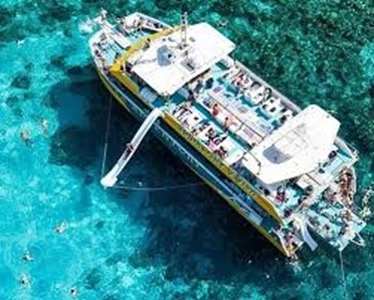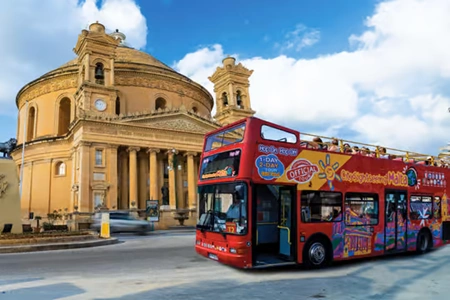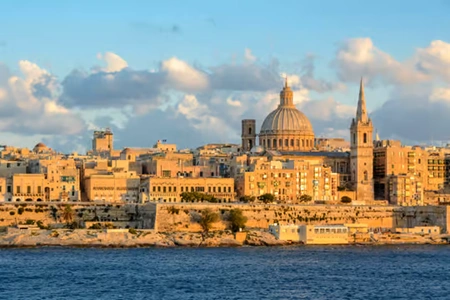
The Grand Harbour
The Grand Harbour is a natural formed harbour area with several creeks, like:
App info: In our app you will find the location, address, opening hours and admission / entrance fee of this spot. If you use the app, you will find additional information and news about this spot on this page.
The history of the Grand Harbour or shipping goes far back in time. From excavations ashore megalithic (Phoenician) remains have been found which indicate the use of the harbour 3700 BC. There , Punician and Roman remains have also been found.
Round the 12th and 13th century Cestrum Maris / Castello del Mare was built, a defensive area, now Fort St. Angelo and which has grown into Birgu. Repair of the galleys could be done here.
The Battle of Malta 1283
An Aragonese fleet of galleys, under command of Admiral Roger van Lauia Crown of Aragon) / Sicilian Vespers) were chasing a fleet of Angevin galleys which were under command of Guillaume Cornut and Bartholomé Bonvin ( house of Anjou ) who were going to relieve the Angevin garrison which was stationed within the walls of Castello del Mare.
After the change Roger of Lauria managed to manoeuvre the fleet and destroyed almost all the ships of Cornut and Bonvin around the Grand Harbour entrance on 8th July 1283.
This crushing defeat forced Charles I of Naples to postpone his plans to attack Sicily.
The succesful rebellion against the rule of the French born King Charles I, who had ruled Kingdom Sicily since 1266, continued. Within six weeks about 13.000 French men and women were killed by rebels and they had the island completely under control. The war of the Sicilian Vespers had started, ( the kings of Aragon of whom Peter III of Aragon, later called Peter I of Sicily played an important role).
The war of the Sicilian Vespers against the Angevin Charles of Anjou, his son Charles II, the Kings of France and the Papacy ended in 1302 with the peace of Caltabellotta.
The Knights of St. John
In 1530 the grand Harbour became the homeport of the Knights of St. John and birgu the new capital of Malta. Here they worked hard to build galleys. In 1776 they started building a shipyard.At the end of he 16th century a devastating tornado raged through the Grand Harbour, which killed 600 people and destroyed an armada of ships.
French Napoleon Bonaparte
General Napoleon Bonaparte was with 30.000 soldiers on the way to Africa. When he came past Malta on the 9th June 1798 he asked to bunker a supply. Grandmaster Ferdinant von Hompesch zu Bolheim reported that not more than four ships could enter at the same time as was included in the articles of the association.The answer by Napoleon was that on 10th June he attacked multiple places at the same time. Because the wars with the Ottomans had dragged on, Malta’s defense was seriously weakend.
About 2000 Maltese militia fought about 24 hours against the French, after which they withdrew into Valletta.
Bonaparte negotiated about taking over and the transfers and the Knights of St. John were exiled to France. On the 19th june Bonaparte left eastwards and sailed with his fleet to Alexandria.
General Claude-Henri Belgrand de Vaubois stayed behind with 3050 soldaten.
The French stopped slavery, inquisition, nobility and feudalism.
In the beginning of September the Maltese uprising started against the French. Malta asked for assistance to free them from the French and the British reacted.
Horatio Nelson, Viscount Nelson, Duke of Burnham Thorpe, United Kingdom, was a British admiral and was one of the most important British opponents at sea of Napoleon Bonaparte and sent a Portuguese squadron of two frigates and four line- battle ships under the command of Marquis Pinto-Guedes de Nizza Reale.
The British formed a blockade against the French. In October 1798 Nizza Reale was replaced by Captain Alexander Ball. Vaubois kept resisting the British. Only on the 5th September, due to lack of food, Vaubois capitulated.
British Period.
In 1827 the Grand Harbour became the base of the British Mediterranean Navy.
During the British period William Scamp was sent to Malta in 1841 to design a drydock facility in the Grand Harbour, because of the strategic location of Malta, an important strong British naval base. He chose the city Cospicua, now part of The Three Cities.
After demolishing historical buildings, the first stone was laid on 28th June 1844 and when a British warship entered on the 5th September 1848, the dock was inaugerated.
The economy of Cospicua consisted of fishery and trade but changed to servicing ships and repairing.
The Crimean War
The strength of the Ottoman Empire failed considerably, which created opportunity for Russia, England and France to claim previous Ottoman’s territories. Many of these territories were situated around the Mediterranean.Much tension occured which caused a war. The fighting parties in this were Russia, who fought against the alliance of more countries like; the British Empire, France, the Ottoman Empire and Kingdom Sardinia ( to which Dutchy Savoye belonged ).
The war was fought between October 1853 and March 1856.
In the war Great Britain chose the side of the Ottoman Empire because of the economical- territorial motives.
The victory was determined by , who had the most advanced technology and the best war industry.
30th March 1856 – Convention of Paris was signed.
The integrity of Ottoman Turkey is laid down in a treaty, Russia must give up Bessarabia, the Black Sea becomes neutral area and the Danube must be opened to international shipping (traffic).
The first technical war had a considerable impact on the maritime activities in Malta.
When the Suez Canal opened in 1869 shipping traffic increased.
Towards 1905 the Naval Dockyard and the British defence services were the base of the Maltese economy.
Security of the harbour
A heavy chain , which runs over the entrance of the harbour from Fort Saint Elmo to Fort Ricasoli, had the function to keep enemy ships outside the harbour.At the end of the 19th century the British admiralty said that the harbour should be better protected against intruders and torpedo attacks, but also, for example, against the north wind which made it difficult to reach the Grand Harbour.
In 1900 the British admiralty planned to build a breakwater over the entrance of the harbour.
King Edward VII laid the first stone of the breakwater on 20th April 1903 and in 1910 was the official opening.
First World War
During the First World War ( 28th July 1914 to 11th November 1918) more than 136.000 men were taken care of in the ‘hospital’ island of Malta. The first patients from the battlefield arrived in March 1915 after several weeks journey on a hospital ship.After many hospital ships were made sunk by German submarines, it was decided that the trip to Malta was too dangerous and the facilities were taken over by Greece. In January 1916 Malta had 27 hospitals, 25.000 hospital beds, 334 medically trained (persons), 913 nurses and 2032 medical workers.
From the Salonika Campaign 78.130 sick and wounded were transported to Malta and from the Callipoli Campaign 5.991 sick and wounded.
Second World War
During the Second World War Malta was heavily bombarded, given the maritime functions and activities, as well as her strategic location.At 16 januari 1941 there was an attack of 61 German junkersbombers in an attempt to destroy the already damaged aircraft carrier HMS Illustrious, óne bomb hit the target and damaged the ship. Each bombing resulted in considerable collateral damage.
At sunrise 26th July 1941 the E-boat unit of the Italian Regia Maria attacked the breakwater in a fierce but vain attempt to gain access to the harbour. All attacking ships were destroyed in the counter attack from land and from ships in the Grand Harbour and also the cannon at Saint Elmo and Fort Ricasoli played an important role.
In 1979 the naval base was closed and in the period 1979-1996 the dock was used for repairing several civil ships.
At sunrise on 26th July 1941 the E-boat-unit of the Italian Regia Marina attacked the breakwater in a fierce but vain attempt to gain acces to the harbour. All attacking ships were destroyed in the counter attack from land and from ships in the Grand Harbour and also the cannon at Saint Elmo and Fort Ricasoli played an important role.
Independence
Malta has known many rulers like the Phoenicians, Romans, Greeks, Arabs, Normans, Sicilians, Swabians, Aragonese, Hospitallers, French and became independant from the United Kingdom on 21st September 1964. The Maltese waved off the British fleet.The military significance of the harbour was lost because of this. The port and docks are still in use and ship activities are still carried out, however with the arrival of the new free port in Birżebbuġa, the Grand Harbour has become considerably quieter compared to the first part of the 20th century.
The daily cruise ships which come and go from different countries and the catamaran to Sicily dominate the waters now and yearly there are rowing competitions on the Grand Harbour in the traditional Maltese fishingboat called ‘dgħajsa’.
Address and street / location can be found on our map, click on Guide in the menu bar and you will get a map with markers. | |
Book: Buy tickets for place of interest. sights, hop on hop off buses, exhibitions, safari, etc or book and tour. | |
Additional information
Background about the Vespers
During a holiday feast (Easter 1282) in Palermo, Sicily a group of French soldiers mixed with the revellers. The French sergeant dragged a young married woman from the crowd and tried to make advances. Her husband attacked the French sergeant with a knife and killed him. When the comrades of the sergeant tried to take revenge, the Sicilian crowd attacked the French and killed them all. All church bells in Palermo started pealing and messengers called all men to help to end the oppression of the French. The result was that the next morning about 2000 French men and woman were killed and the rebels completely controlled the city.The Sicilian Vespers had started.
The succesful rebellion against the rule of the French born King Charles I, who had ruled Kingdom Sicily since 1266, continued. Within six weeks about 13.000 French men and women were killed by rebels and they had the island completely under control. The war of the Sicilian Vespers had started, (the kings of Aragon of whom Peter III of Aragon, later called Peter I of Sicily played an important role).
The war of the Sicilian Vespers against the Angevin Charles of Anjou, his son Charles II, the Kings of France and the Papacy ended in 1302 with the peace of Caltabellotta.
The Knights of St. John.
Map of the port The Grand Harbour en Marsamxett Harbour and creeks around Valletta.

Painting: approach to the Grand Harbor in bad weather.
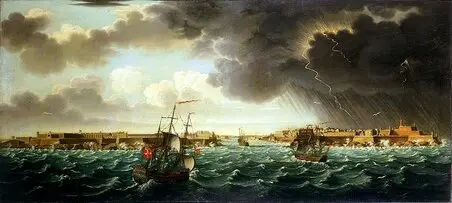
Sketch: The Grand Harbor in a quiet period.
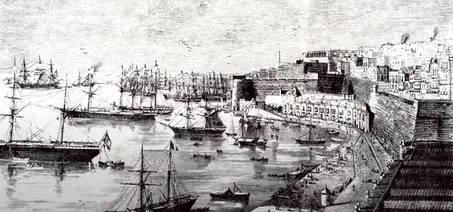
Photo: Also look at the armament of the ships.
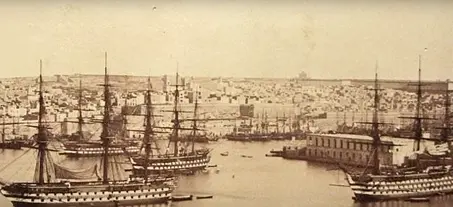
Photo: The harbor busy during WWII.
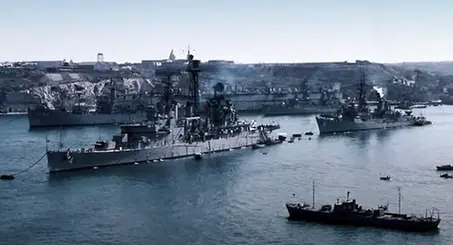
The four pictures below show how the large cruiseliner enter the port. From the bridge, everything seems so close.
There are cruise liners with 6,500 guests on board. Often 2/3 will spend a day visiting the country. One then does a tour through the country and visits Valletta. Sometimes there are four cruise liners in a day.


Photo from the bridge in the Grand Harbor.

Everything seems within reach from the bridge.

